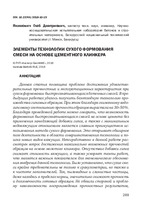Элементы технологии сухого формования смеси на основе цементного клинкера
Another Title
Elements of dry forming technology of mixture based on cement clinker
Bibliographic entry
Якимович, Г. Д. Элементы технологии сухого формования смеси на основе цементного клинкера = Elements of dry forming technology of mixture based on cement clinker / Г. Д. Якимович // Проблемы современного бетона и железобетона : сборник научных трудов / Министерство архитектуры и строительства Республики Беларусь, РУП "Институт БелНИИС". – Минск : Колорград, 2018. - Вып. 10. – С. 289-305.
Abstract
Данная статья посвящена проблеме достижения удовлетворительных прочностных и эксплуатационных характеристик при сухом формовании быстросхватывающихся бетонных смесей. В предыдущих работах удалось получить безотходную технологию производства гипсовых образцов. При этом благодаря сниженному водогипсовому соотношению прочность образцов вырастала на 30–50 %. Благодаря проведенной работе можно говорить, что возможность формования быстросхватывающихся смесей на основе цемента без применения замедляющей добавки гипса, а также с минимальным водовяжущим отношением является главным преимуществом использования метода сухого формования. Это открывает обширное поле деятельности в области совершенствования технологии и поиска новых видов вяжущих. Непосредственно в данной работе рассмотрен вопрос достижения максимально возможных прочностей образцов на основе молотого клинкера. Отсутствие добавки гипса снижает стоимость вяжущего, а также ускоряет темпы работ, что является важным показателем для экономического обоснования внедрения данной технологии. Было установлено, что сухие смеси крайне требовательны не только к гранулометрии, но также и к чистоте заполнителей. Так, пылевидные и глинистые частицы, даже находясь в пределах нормы, значительно снижают прочность и долговечность готовых образцов. Не обошли стороной и проблему невозможности воспроизведения прочностных результатов, представленных в свое время советскими и зарубежными учеными. Проводимая в начале 2000-х годов модернизация белорусских цементных заводов полностью изменила свойства белорусского цемента, что повлекло за собой падение прочности образцов сухого формования с 80 до 50 МПа. В данной статье проводилась оценка влияния гранулометрии цементного клинкера на прочностные характеристики мелкозернистого бетона. Данные опыты лишь подтвердили общеизвестные зависимости между прочностью вяжущего и тонкостью его помола. Тем не менее, достигнутая прочность образцов является довольно высокой, что позволило рассмотреть вопросы долговечности образцов для оценки класса по условиям эксплуатации. По результатам испытаний образцы показали высокую морозостойкость, что делает технологию пригодной для изготовления изделий и конструкций, находящихся в условиях попеременного замораживания и оттаивания.
Abstract in another language
This article is devoted to the problem of achieving satisfactory strength and performance characteristics of the dry forming of quick-setting concrete mixes. In previous works, we were managed to get a non-waste technology for the production of gypsum samples. At the same time, due to the reduced water-gypsum ratio, the strength of the samples increased by 30–50 %. Due to the work carried out, it can be said that the ability to form quick-setting cement-based mixtures without the use of a gypsum retarder, and also with a minimum water-binding ratio is the main advantage of using the dry-molding method. This opens up a vast direction of activity in the field of improving technology and searching for new types of binders. Directly in this paper, the issue of achieving the maximum possible strengths of samples based on ground clinker was considered. The absence of a gypsum additive reduces the cost of the binder, and also speeds the pace of work, an important indicator for the economic justification for the introduction of this technology. It was found that dry mixtures are extremely demanding not only for granulometry, but also for the purity of aggregates. Thus, pulverized and clay particles, even within normal limits, significantly reduce the strength and durability of the finished samples. We were not bypass the problem of the impossibility of reproducing strength results, presented in due time by Soviet and foreign scientists. The modernization of the Belarusian cement plants in the early 2000s completely changed the properties of the Belarusian cement, which led to a drop in the strength of dry molding samples from 80 to 50 MPa. In this paper, the effect of the granular cement of cement clinker on the strength characteristics of fine-grained concrete was assessed. These experiments only confirmed the well-known relationships between the strength of the binder and the fineness of its grinding. Nevertheless, the achieved strength of the samples is quite high, which allowed us to consider the issues of durability of the samples for assessing the class in terms of operating conditions. Based on the test results, the samples showed high frost resistance, which makes the technology suitable for the manufacture of products and structures under alternating freezing and thawing conditions.

